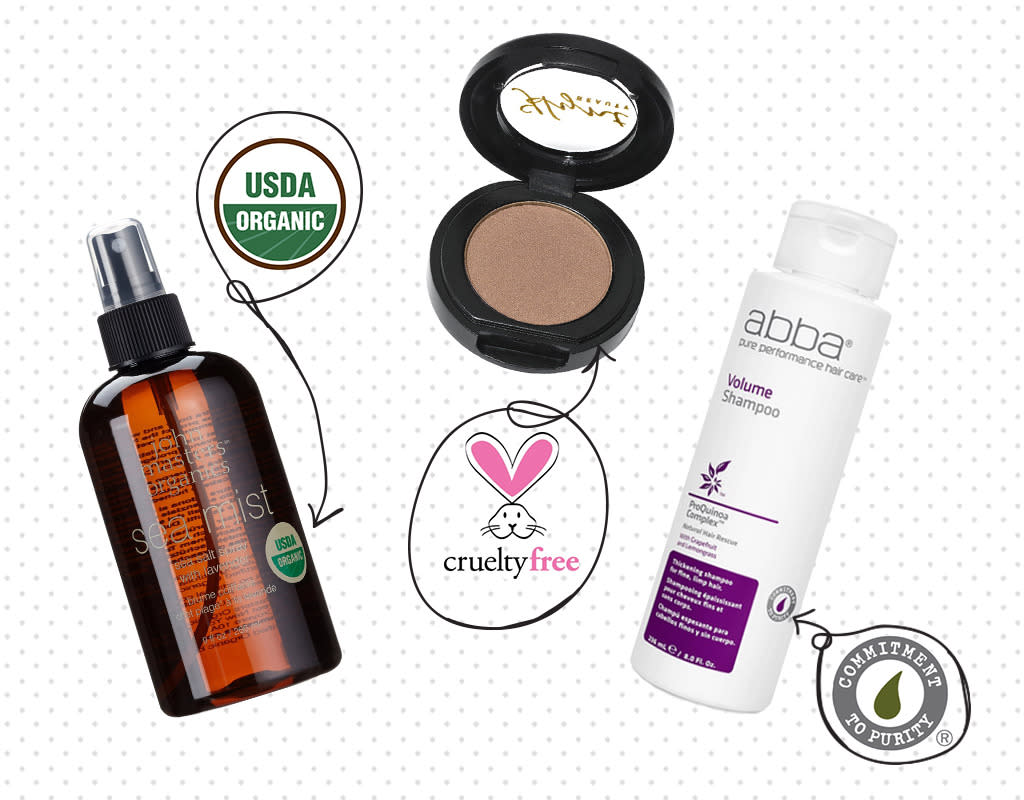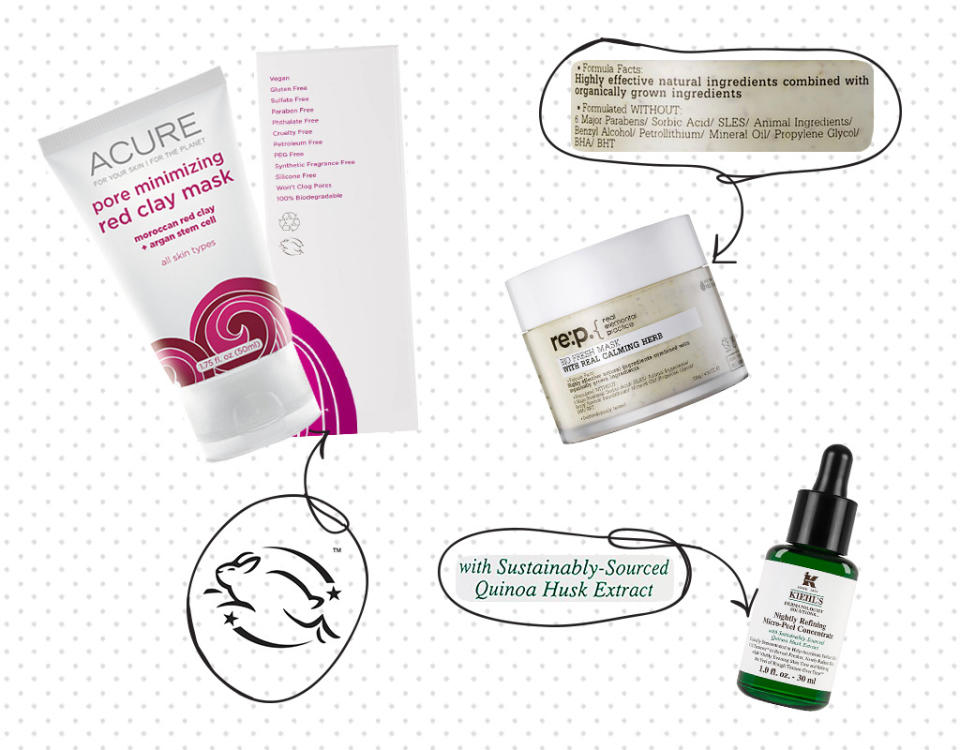Happy Earth Day! How to Make Sense of Eco-Friendly Labels on Beauty Products

Beauty brands pledging environmental responsibility include, from left, John Masters, with products bearing the USDA Organic symbol; Hynt Beauty, which is certified vegan and cruelty-free; and 25-year-old Abba, which is not third-party certified, but which says its products are vegan, cruelty-free, and paraben-free. (Photo: John Masters/Hynt Beauty/Abba/Yahoo Beauty)
If you’re a beauty consumer who holds certain earth-friendly principles dear even when it’s not Earth Day — animals rights, for example, or a desire to not support pesticide use or swipe carcinogens onto your eyelids — you probably know that finding clear and trustworthy guidance while shopping can be a frustrating proposition. That’s because, while food labeling might be tricky (hello, sneaky GMOs), the endless range of labels found on health and beauty products is downright labyrinthine.
Related: How Chemicals Used In Beauty Products May Be About to Change
“There is such a variety in labels, so it can be very hard for a consumer to make sense of it all,” says Charlotte Vallaeys, a senior policy analyst at Consumer Reports, which offers a thorough analysis of product labels through its online Greener Choices database. “A company can really be committed to doing the right thing, and we encourage that, but where it gets tricky is how does a consumer know when the claims are meaningful?”
According to the database, a vast majority of beauty product label claims — Natural, 100% Vegan, Cruelty-Free, Hypoallergenic, Non-Toxic, Sustainably Sourced, Environmentally Friendly, and No Animal Testing, just for starters — are generally meaningless.
Related: Black Women’s Hair Products Are So Toxic, This Organization Is Demanding Change
Vallaeys tells Yahoo Beauty that in compiling that information, analysts look at various criteria behind company claims: Is there a conflict of interest at play? Has it been independently verified and written by the company itself, or has the company worked with scientists and public-interest groups, such as the Consumers Union (of Consumer Reports)? “The problem is, you can’t tell by looking at a label if it’s third-party verified,” she says.

Acure is certified cruelty-free by the Leaping Bunny, RE:P lists its many attributes, certified by third parties including the Leaping Bunny, and Kiehl’s notes on its Nightly Refining Micro-Peel Concentrate that its quinoa husk extract is “sustainably-sourced” — something it verifies on its website through a partnership with Proinpa in Bolivia. (Photo: Acure/RE:P/Kiehl’s/Yahoo Beauty)
This is part of the reason why many independent certifying bodies have begun issuing their own labels and symbols and certifications, typically following inspections or company affidavits, along with fees.
Among the newest certifications is from the Environmental Working Group (EWG), known by healthy-beauty aficionados for its popular Skin Deep database that rates chemical additives for safety and toxicity. It recently launched its own EWG Verified label, with its presence indicating the absence of toxic ingredients. So far 118 products — including those from brands Beautycounter, Just the Goods, Rejuva Minerals, and Biossance — have passed the assessment by turning over ingredients affidavits and paying fees ranging from $200 to several thousand dollars. To make the cut, products must have not one of more than 2,700 “unacceptable” chemical additives, many of which are commonly used in everything from skin lotions to lipsticks. (Biossance has also just this week released its own blacklist of more than 2,000 ingredients you’ll never see in their products, challenging other brands to do the same.)
“We looked around the cosmetics sphere and didn’t really see a way for a consumer to see in the store that there were no toxic ingredients,” Nneka Leiba, EWG’s deputy director of research, tells Yahoo Beauty. The organization came up with its own certification as a way “to empower” shoppers, she says, adding, “Ultimately, what we think should happen is stronger [governmental] regulations, so our mark and the Skin Deep database becomes unnecessary.”

PETA’s Beauty Without Bunnies certification. (Image: PETA)
Leiba is referring to the fact that there is barely any regulation of the $60 billion-a-year makeup and skin products industry — and that the weak federal Food, Drug and Cosmetics Act, which is supposedly there to provide it, was last updated in 1938. The bipartisan Personal Care Products Safety Act now awaits federal hearings in an attempt to make products safer. (For the sake of comparison, the EU bans more than 1,300 chemicals from personal-care products, while the U.S. has banned only 11 ingredients, including such poisons as mercury and chloroform.)
Adds Vallaeys, “We definitely think there’s value to having government oversight of labels.”
To help you wade through the eco-label claims, experts suggest starting by looking at the ingredients, and then checking for anything worrisome or unfamiliar on EWG’s Skin Deep database. Regarding claims that aren’t about toxicity or purity, keep an eye out for the following certifications, all of which are third-party verified and tightly controlled:
Certified Vegan The Certified Vegan Logo, issued by the non-profit Vegan Action, is a registered trademark for products that do not contain animal products or byproducts, and that have not been tested on animals. The organization defines vegan as: “no animal or animal by-products to include flesh, bones, dairy, eggs, honey, fur, leather, wool, down feathers, and cosmetics or chemical products tested on animals.”
EWG Verified The Environmental Working Group’s new label indicates the absence of nearly 3,000 toxic ingredients, including those that are known carcinogens or endocrine disruptors, as well as any banned by the EU or Canada.
Fair Trade Certified Fair Trade Certified products were made “with respect to people and planet,” the website explains. “Our rigorous social, environmental and economic standards work to promote safe, healthy working conditions, protect the environment, enable transparency, and empower communities to build strong, thriving businesses.” Though most commonly seen on food items, there’s now a small but growing list of personal care products with the seal, because of ingredients such as shea butter, cocoa butter, exotic oils, sugar, honey, coffee, tea, herbs, fruits, and flowers. Some certified brands include Aura Cacia, Eco Lips Inc, Nourish Organics, and WS Badger Company Incorporated.
Leaping Bunny Established through the efforts of eight national animal-protection organizations, including the Humane Society and Beauty Without Cruelty, the Leaping Bunny program certifies that products are cruelty-free. That standard, according to its definitions, include no animal testing of products, including of third-party ingredients, based on a strict monitoring system.

The Leaping Bunny symbol. (Photo: Leaping Bunny)
Natural Products Association Certified (NPA) While the word “natural” on labeling is so meaningless that the Consumers Union recently petitioned the USDA and FDA to ban its use (with a comment period that is currently open), this organization brings it some purpose. The standard for certification, according to its website, are based on natural, non-toxic, and biodegradable ingredients; no animal testing; and “environmentally sensitive packaging.” It includes bans on additives including triclosan, phthalates, formaldehyde, and formaldehyde releasers.
Non-GMO The Non-GMO Project offers North America’s only third-party verification and labeling for non-GMO products, including beauty items. Certified brands include Desert Essence, Dr. Bronner’s, EO, Kiss My Face, and Neal’s Yard Remedies.
PETA-Approved Cruelty-Free This more cutesy version of the bunny is licensed through PETA as part of its “Beauty Without Bunnies” program. It can indicate a product being either vegan or against animal testing or both. “By purchasing only cruelty-free products, you can help save rabbits, mice, guinea pigs, rats, and other animals from excruciating tests and a lifetime of suffering,” explains the website, which also has a searchable database of products.
USDA Organic Federal law regulations require that any product bearing this or any other organic label (including others, most even more stringent, from various regions of the U.S.) must have been produced by adhering to comprehensive standards that promote sustainability and minimize use of pesticides, antibiotics, irradiation, and other aids. (Other countries issue organic certification labels, too, including Australia, Italy, New Zealand, and Switzerland.)
Let’s keep in touch! Follow Yahoo Beauty on Facebook, Twitter, Instagram, and Pinterest.



